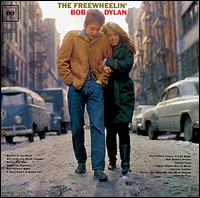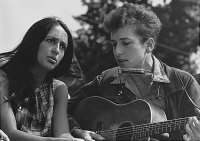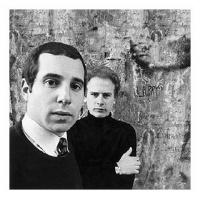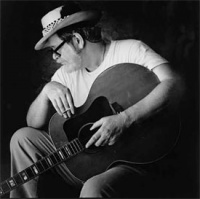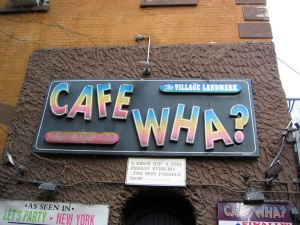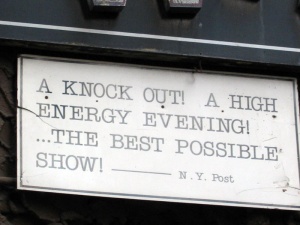The Folk Revival in the Village
From The Peopling of NYC
Folk Revival
Folk music came to the Village in 1945 when a printer named George Margolin started performing near the Washington Square Park fountain. By 1960, the Park was teeming with hundreds of young aspiring musicians.
In its first years, the Greenwich Village folk scene adhered to the labor theory of value. Most musicians sang and played for free in Washington Square and passed a basket for change in coffeehouses. In the late 1940s, coffeehouses had popped up all over the area, featuring folk music.
[edit] People
The sort of “Bob Dylan slept here” nature of Greenwich Village went beyond just Bob and extended to most musicians of the genre. Nearly every folk musician/group has played the Village. The following is just a small sampling of the hundreds of singers and musicians who passed through there.
Bob Dylan
Born 1941 in Duluth, Minnesota.
Bob Dylan arrived in Manhattan, determined to make it big, on January 24, 1961. He played Café Wha?. After that, he played all over the Village. Every hole in the wall had a coffeehouse or a nightclub, and Bob performed at most of them. A good number of his songs make references to Greenwich Village, notably, "Positively 4th Street."
Bob Dylan Performing
Joan Baez
Born 1941 in Staten Island.
She was a folk singer who began her career in 1959 at the Newport Folk Festival.
Woody Guthrie
1912-1967
Dylan and most folk-revivalists began by singing his songs. He was hospitalized with Huntington's disease by the time the folk revival had begun, but Dylan, Baez, Phil Ochs, and other would visit him in the hospital and sing his songs to him. Among his songs is "This Land is Your Land."
Arlo Guthrie
Born 1947
Woody Guthrie's son, his songs include the rather lengthy "Alice's Restaurant."
Ramblin' Jack Elliot
Born 1931
He was a heavy influence on Bob Dylan.
Phil Ochs
1940-1976
Best known as a protest singer.
Simon and Garfunkel
Formed 1957
Their "Bleecker Street" makes reference to Allen Ginsberg's Howl: "A poet reads his crooked rhyme/'Holy, holy' is his sacrament."
The Mamas and the Papas
Formed 1965
John Phillips started in Greenwich Village with his first band, The Journeymen. There, he met his future bandmates, Denny Doherty and Cass Elliot. The group's early days are referenced in their song, "Creeque Alley."
Joni Mitchell
Born 1943
Her songs include "Woodstock," which Crosby, Stills, Nash, and Young famously covered.
Rabbi Shlomo Carlebach
1925-1994
A Hasidic rabbi and master storyteller. Although much of his material was in Hebrew, he gained fame singing in the folk music clubs in Greenwich Village along with other international performers.
Theodore Bikel
Born 1924
He was a Jewish folksinger and character actor who would cofound the Newport Folk Festival (with Pete Seeger and George Wein), and would later go on to play Tevye in Fiddler on the Roof.
New Lost City Ramblers
Formed in 1958 by Mike Seeger, John Cohen, and Tom Paley
Unlike most folk groups of the time, who sanitized the southern folk music, The New Lost City Ramblers strove for authenticity.
The Clancy Brothers
Formed 1955
Group singing Irish folk music.
The Weavers
Formed in the Village in 1947 by Ronnie Gilbert, Lee Hays, Fred Hellerman and Pete Seeger
They were one of the first folk groups on the scene. The group disbanded in 1952 and Pete Seeger continued working solo.
Richie Havens
Born 1941
He rose to fame in the Greenwich folk scene and would go on to open the Woodstock Music Festival in 1969.
Dave Van Ronk
1936-2002
The "Mayor of MacDougal Street," Van Ronk was one of the founders of folk-blues. A section of Sheridan Square is named after him.
Peter, Paul, and Mary
Formed 1961
The group debuted in 1961 at The Bitter End. Mary Travers worked as a waitress at Cafe Wha? when she met up with Peter Yarrow.
[edit] Places
They sang and played in clubs and coffeehouses throughout the neighborhood. Nearly every spare room or basement would house a small club or coffeehouse at some point. Some of the more established haunts of these folk artists included:
Cafe Wha?
115 MacDougal Street
Where Dylan first played. Jimi Hendrix hung out there, among many others.
The Bitter End
147 Bleecker Street
Extant 1961-2004. Everybody played there.
The Gaslight Cafe
116 MacDougal Street
Opened in 1958, as a basket house, a place where musicians would earn the proceeds of a passed-around basket.
Folklore Center
110 MacDougal Street
Opened April 1957, Dylan hung out there checking out folk recordings and writing songs on the typewriter in the back room.
Gerde's
71 West 4th Street
Opened by Mike Porco in 1952, it became a folk club in 1960. It had Monday night hootenannies and it was one of the most important venues on the Greenwich scene. It was here that the NY Times reporter Robert Shelton wrote the review of Bob Dylan that would catapult him to fame.
The Village Vangaurd
178 7th Avenue South
Opened in 1935 as a comedy and poetry club. The Weavers played here in 1949. In 1957, the club switched to an all-jazz policy.
The Village Gate
160 Bleecker Street
Opened in the late 1950s. Aretha Franklin made her first New York appearance here. Renowned Hasidic singer and storyteller Rabbi Shlomo Carlebach performed here and the live recording of his concert became his third album in 1963. Dylan wrote "A Hard Rain's A-Gonna Fall" in the basement.
and many others.
"I was at Gerde's maybe three or four times. I never did a gig there, officially. I sang with Bob a couple of times impromptu, and that's also where I met him and saw him for the first time. I went to the Café Wha? and a couple of other places.... But I didn't hang out a lot in New York City. I was very aware that that's where everything was happening."
-Joan Baez, L. A. Johnson Interview, Bloomington, IN, Aug 28, 1995
Roots of Bob Dylan
Simon and Garfunkel
CBGB
The Bitter End
Bob Dylan
Sources:
Hajdu, David. Positively 4th Street: The Lives and Times of Joan Baez, Bob Dylan, Mimi Baez Farina, and Richard Farina. 2001.
